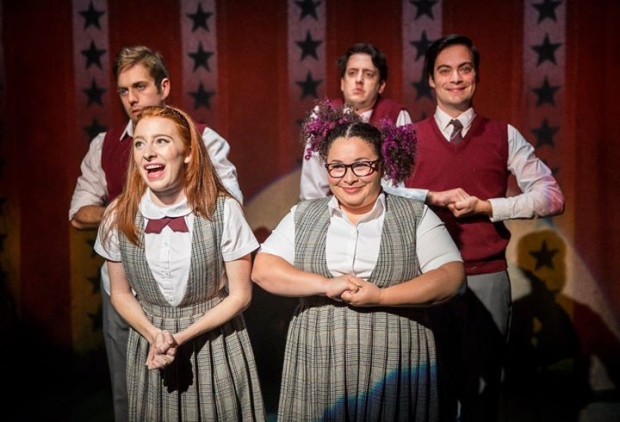Ride the Cyclone
Death comes to the theme park in Chicago Shakespeare Theater’s U.S. premiere of this Canadian-born musical.

(© Liz Lauren)
A synopsis of Ride the Cyclone sounds not unlike a variation on the musical Forever Plaid, where six teenage choir members are killed in a freak accident, meet in the afterlife, and explore their lives in song. Now receiving its U.S. premiere at Chicago Shakespeare Theater, Ride the Cyclone was in fact once marketed with a nod to Forever Plaid. Born in Victoria, British Columbia, the show's Vernon, B.C., run was announced with ads blaring, "If you loved Forever Plaid, Come See Ride the Cyclone!"
Though it might sound Plaid-ish on the surface, it is wholly its own beast. Cocreators Jacob Richmond and Brooke Maxwell have written a piece that is both enthralling and unnerving. Think Waiting for Godot (which is excerpted in one hilarious scene) meets The Breakfast Club and you'll have a tiny idea of this show's sensibility. Still, it's unfair to compare Ride the Cyclone to anything, because it is so original. It deals in familiar teen tropes — the outcast, the mean girl, the angry trouble-maker — but it never dips into cliché. Rather, it is a profound rumination on death that's never pretentious, and a celebration of life that's never sentimental. Darkness abides under the carnival lights that illuminate the show's fun-house atmosphere. But director Rachel Rockwell also highlights the sheer joyousness inherent to the show.
The story begins with the Amazing Karnak (voiced by Karl Hamilton), a mechanical soothsayer locked in the booth of a seedy traveling carnival with his cheesy crystal ball. Karnak describes, in his thoroughly creepy monotone voice, the impending roller coaster derailment while the six teens stand by, dazed and confused at finding themselves dead. One of them, Karnak announces, won't stay that way. At the close of the 90-minute show, there will be a vote among the choir members. And whoever wins the election can return to world of the living. But before the vote, the teens will each get a chance to argue their case in song.
In a roster of treasures, arguably the most memorable number is "The Ballad of Jane Doe," performed by Emily Rohm as the sole unidentified Cyclone rider. Decapitated in the accident, Jane Doe wanders the stage like a broken doll with vacant, pitch-black eyes. The ballad is incandescent, and Rohm soars through its upper-stratosphere notes with an effortlessness that doesn't seem of this world. As mousy Constance Blackwood, Lillian Castillo brings the house down with "Sugarcloud," a hard-charging exploration of what it's like to go through life invisible and self-loathing. The contrast between the song's raucously upbeat style and its bleak content is jarring. The cruelty of the lyrics will make you angry and sad, while the fizzy pop hooks will make you want to dance.
As Noel Gruber, Kholby Wardell delivers a sultry siren song so vivid, you can practically smell the cigarettes and pheromones that filled the air in the cabarets of 1920s Paris. As the belligerent Mischa Bachinski, Russell Mernagh nails the duality of an angry, young man whose armor of rage can't hide the shattered loneliness beneath. Tiffany Tatreau's perky overachiever Ocean O'Connell Rosenberg, is the girl everyone secretly hated in high school. As the head cheerleader, student council president, drama club star, and straight-A Honor Society member mean girl, Tatreau's hilarious delivery of "What the World Needs Is People Like Me" is an open invitation to hubris. (That's not long in coming.)
There's also wonderful work by Jackson Evans as Ricky Potts, a doleful young man with crutches and leg braces. Hurling away his hardware and his school uniform, he morphs into the long-lost space glam soul brother of Ziggy Stardust, vividly showing the audience why he's known as "the most imaginative boy in town."
Like that killer cast, the creative team is also on point. Lighting designer Greg Hofmann and set designer Scott Davis have constructed a carnival crossed with an Edward Gorey cartoon, where the flashing bulbs and neon seem to illuminate pockets of peripheral vision that you don't want to see too closely. Mike Tutaj's projection design is crucial to the production, as scenes from each student's life flicker on the carnival's awning. At one point in Mernagh's solo, the women in the cast appear in flowing white skirts and floral head bands (lovely work by costume designer Theresa Ham), with the skirts themselves becoming movie screens flickering with images of lost love. And nothing onstage would work without sound designer Palmer Jankens, who makes every note audible whether it's a blast of full-throttle rock or the hushed tones of a solo concertina. Under the baton of keyboardist Michael Kaish, the five-man onstage band creates a soundscape that seamlessly flows between genres, moods, and instruments.
Ride the Cyclone is a wild journey from start to finish, but its spectacle never eclipses the profound, unanswerable questions about the lives and deaths into which it delves. The most frightening thing about death, opines one of the students, is the fear that you'll wake up in a world where everybody who loves you is gone. It's the sort of sentiment that'll keep you up nights, and this show is filled with them.
Subversive in its utter unwillingness to traffic in the sentimental, filled with a score of showstoppers, and featuring a crew of characters as instantly familiar and indelibly vivid as your immediate family, Ride the Cyclone is a marvel. Here's hoping the ride doesn't stop in Chicago.









